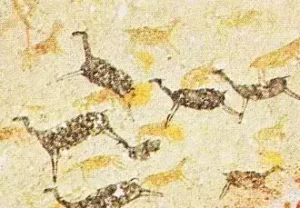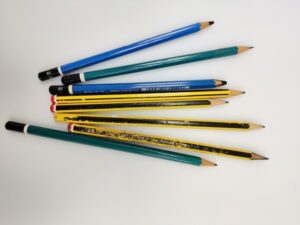 Who invented the pencil and what is its history? In researching this ordinary item which we probably never really consider and simply take for granted, I found conflicting information about its beginnings. So, I decided to go back even further to consider mark making as a starting point.
Who invented the pencil and what is its history? In researching this ordinary item which we probably never really consider and simply take for granted, I found conflicting information about its beginnings. So, I decided to go back even further to consider mark making as a starting point.
We are all no doubt aware of the ‘paintings’ made by cave dwellers. In 2018, researchers announced that the oldest known cave paintings, which were made by Neanderthals, are at least 64,000 years old. Wow, I find that incredible! You can of course Google this yourself, but these paintings were discovered in caves at Cueva de las Monedas, Cantabria, Spain.
For copywrite reasons I am not including any images, but if you click on the link here it will take you straight to the photo gallery for the caves website. https://cuevas.culturadecantabria.com/las-monedas-2/photo-gallery/

In more ancient times, the cave artists of the Palaeolithic era (roughly 2.5 million years ago to 10,000 B.C.) made their paints and drawings using charcoal and natural pigments such as ochre. However, most cave art was made using iron oxides (hematite) for reds and manganese dioxide and charcoal for black. The artists made their marks with their hands but also used brushes formed from leaves and reeds which they appear to have blown through to apply the material to the cave walls.
Having read through a lot of material and tried to make sense of it all, I believe the information provided by the British Library is without doubt the most reliable. So, having gone through all the research, my conclusion is that the modern-day pencil as we know it, which uses graphite as the main drawing element, was invented by Nicholas-Jacques Conté in 1795 whilst he was serving in Napoleon Bonaparte’s army as an officer and member of the scientific corps.
Prior to that, notably during the Middle Ages, lumps of lead were used for drawing and for planning manuscripts. Because lead leaves a silvery line when used, it can easily be written over, using ink and/or paint. It is because lead was originally used that we still to this day talk about lead pencils, when in fact lead hasn’t been used since before the Conté invention.
Dating back to the Gothic/late Middle Ages (14th century) and then throughout the renaissance period up to the end of the 17th century, Silverpoint was used but it wasn’t at all easy to erase. Silverpoint is a small, pointed silver-tipped instrument which when used over a specially prepared abrasive surface, leaves a small amount of the metal behind.
This prepared surface, which was usually paper, was coated in a mixture of gum-water, powdered bone ash, chalk or lead white, with several layers being applied to create a slightly abrasive surface. This produced an off-white “ground” or undercoat, which could then be (and often was) tinted with pigments. Renaissance artists such as Leonardo da Vinci, Jan van Eyck, Raphael and Albrecht Dürer commonly used this method of drawing.
This form of drawing is also called metalpoint and there are variations of this method which use copper, brass, gold or platinum. The metals each have their own softness and so react with the ground, which oxidises, in different ways.
Returning to the modern pencil, Conté roasted a mixture of water, clay and graphite in a kiln, heating it up to 1,900 degrees Fahrenheit (1037.88 Celsius). The resulting mixture was then encased in two halves of a wooden cylinder to make it easier to use. The hardness or softness of the pencil could be modified by adjusting the amount of clay and graphite to produce the required outcome.
In fact, the Aztecs used graphite to make marks several hundred years before the mineral was first discovered in Europe, in Bavaria. The Bavarians started using this product at the start of the 15th century however the purest deposits of graphite were discovered near Keswick in the Lake District of Northeast England at a place called Borrowdale, in 1564.
This graphite was welcomed for its ability to leave darker marks than lead and was so highly valued that it created a huge smuggling industry as it was sold on the black market in that area.
To hold it together the graphite was initially wrapped with string as it proved to be too soft and brittle to handle. Later it was encased in hollowed-out wooden sticks, which was when the modern-day pencil was really born.
The 19th century saw a massive trade in graphite pencils in the Keswick area, with the first pencil factory being opened in 1832. The company was initially called Banks, Son & Co but is now known as the Derwent Cumberland Pencil Company. Pencils made by Derwent were considered to be of the highest quality and today the company still holds an excellent reputation for the pencils they make. But back in the day their pencils were regarded as the highest quality because the graphite they contained did not leave any dust on the paper and they also marked the paper clearly.
As an aside, the original graphite was solid and dense, meaning that the marks left on the paper were not very easy to see. However, if the graphite was wetted or licked, the marks would appear darker on the paper. I can remember my grandfather would always lick his pencil before using it to make darker marks. I would say that it is not actually necessary but maybe it was something he learned from his father.
As this is such a huge subject, I have broken it down into two parts. Next time I will write more about modern pencils and how they are made today.
NB Just for the record, I do not get paid to endorse any of the brands I have mentioned above.
If you have enjoyed reading this post, please like and follow me and please share it with people who you think might be interested. I am always on the lookout for new artists to feature as I know how much everyone enjoys reading about other artists. Also, if you think there is a subject you would like to know more about and would like me to write about, I will be happy to consider it. Sharing, liking and following my blogs increases the number of people the algorithm shows the blogs to, so please share. Thank you in advance for supporting me this way.
